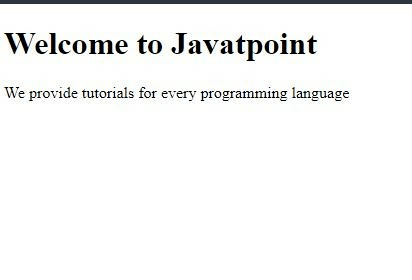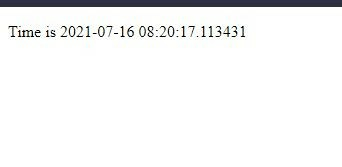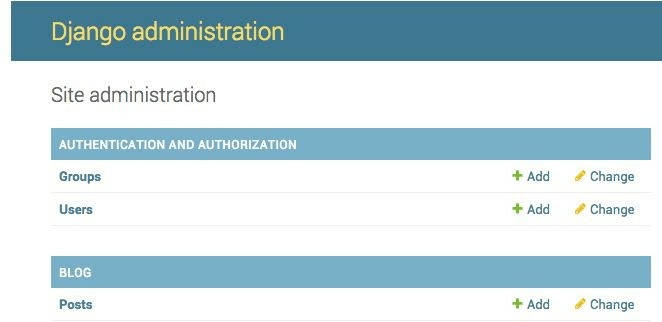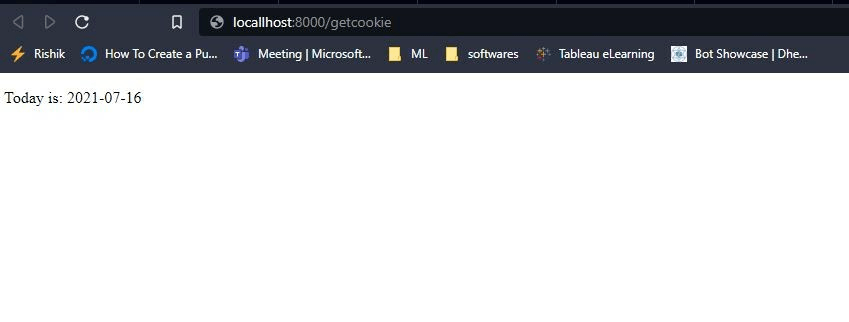Django Interview Questions for 2022
Django is an open-source python web framework. It is very popular due to the functionalities it offers. It uses the Model-View-Template architecture. Many giant organizations are using Django as their primary backend framework. Django is one of the most demanded skills among the recruiters.
In this post, we will see some Django Interview Questions, which you can take a look at before going for your next interview.
1. What is Django?
Django is an open-source and free-to-use Python-based web framework. It is known for its rapid development and efficiency. It takes care of common problems so that we don't have to write an application from scratch. The final version of Django was released in 2008.
2. What architecture does Django use?
Django uses the Model-View-Template architecture. It consists of Model, View, and Template. It consists of three major parts.
- Model: Model is the most basic part of a Django app. It contains information about the data. Every field of the model represents the column of the mapped table.
- View: View is the part that a user sees on the website. Views are written in HTML/CSS/JavaScript and Jinja files.
- Template: A template is used to render the dynamic content of websites. A template consists of both static and dynamic parts of HTML.
3. Name all the inheritance styles in Django.
Currently, Django supports three inheritance styles. These are Abstract Base, Multi-table, and Proxy models.
- The abstract base model is used to display some data in all other models.
- Multi-table inheritance is used to create links between the parent model and the child model. All the child of the parent model is model itself and has a separate database.
- The proxy model is used when we want to perform CURD operations on the instance of the original model, not directly on the original data.
4. What are the features of Django?
Django is very popular for its features like:
- SEO friendly
- Rapid Development
- Secure
- Scalable
- Versatile
- Batteries Included
5. Explain the Models in Django.
A model contains information about the data. Almost all of the model is mapped to a table in the database. The fields in a model are the column name of the mapped table. The model defines the structure in which data stores.Django models provide consistency to the app.
An example of a Django model is:
From Django. db import models
Class Javatpoint(models.Model):
title = models.Charfield(max_length = 300)
author= models.Charfield(max_length = 100)6. Explain the project structure of Django?
The basic structure for the Django projects looks like this:
- manage.py: We can interact with the Django app.
- __init.py: It is an empty file; it decides that the current directory is a python package.
- Urls.py: Contains the URLs for the website.
- Settings.py: It contains the configurations for the various settings like database connection, INSTALLED_APPS, MIDDLEWARES, etc.
- Wsgi.py: This is the main entry for the server.
7. Disadvantages of Django.
Some of Django’s drawbacks include:
- Django is considered to be monolithic, so not suitable for small projects.
- Django cannot handle more than one request simultaneously.
- Tough for beginners
8. What is Django ORM?
Django Object Relation Mapper helps to retrieve or query the database tables without actually using any SQL. It is used to communicate between database and application. ORM helps in the rapid development of web applications. The programmer does not have to write actual queries in SQL, and he only has to write in Python.
Example:
models.objects.all()
Models.objects.get(query)
Models.objects.filter(query)9. How to connect the Django project to a database?
To connect the project to a database, use the following commands:
- Python manage.py migrate
- Python manage.py makemigrations
- Python manage.py sqlmigrate
10. What is CRUD?
CRUD refers to create, read, update and delete. These are the most basic operations which a database or an API supports. It is used to fetch the information from the database to the website.
11. What are templates in Django?
Templates are used to create dynamic web pages in Django. We can add as many templates as we want. The template layers output the information to be processed in a designer-friendly format.
Django provides a built-in backend for the template called Django-Template-Language. Django also provides the API to load and render templates.
Example:
<!doctype html>
<html>
<head>
<meta charset="utf-8">
<title>First Template</title>
</head>
<body>
<h1>{{ title }}</h1>
<p>{{ pargraph }}</p>
</body>
</html>Views.py:
From Django. shortcuts import render
Def javatpoint(request):
Context = {
“Title”: “Welcome to Javatpoint”,
“paragraph”:”We provide tutorials for every programming language”}The output will be like this:

12. What are Views?
View in Django is the user interface for the app. It is commonly written in HTML\CSS\JavaScript. A view is a function that accepts a request and returns a response. The response varies on the request received. Views consist of the logic of the application.
Example:
from Django.http import HttpResponse
import datetime
# create a function
def new_view(request):
time = datetime.datetime.now()
html = "Time is {}".format(time)
return HttpResponse(html)
13. Explain Signals.
The signals in Django notifies the applications when actions happen in the project. Django is utilities that associate actions with events. The most common signals are:
- Pre_save/post_save:This signal is called before and after saving an object.
- Pre_delete/post_delete:It is used after and before using method delete().
We can connect a signal with either function or decorators. An example of connecting with function is:
post_save.connect(save_function, sender=New_model)14. Difference between MVC and MVT.
MVC stands for Model-View-Controller and MVT for Model-View-Template. The stand-out difference between them is MVC; we have to take care of the control-specific code, while in MVT, it gets taken care of by the framework. In MVC, the rendering is dependent on views, while in MVT, the templates decide what is getting displayed to the user. Modifications are difficult to make in MVC, but in MVT, modifications can be made swiftly.
15. Explain the statement – Django is Monolithic.
Django as a framework requires some rules and file structure to be followed by developers. Also, Django has many added functionalities as well.
In Django, we cannot change the name of existing files. The monolithic nature is helpful for big projects, but for smaller ones, it is too much.
16. Explain the use of Sessions in Django.
Sessions are used to store the information about a user when he visits a site. They are implemented by using middleware in code.
Sessions are used to handle cookies. The data stored is saved on the server-side. Sessions can also store data when the user is not accepting cookies in their browser. To use the sessions, include this code in settings.py:
In MIDDLEWARES section:
'django.contrib.sessions.middleware.SessionMiddleware'INSTALLED_APPS:
‘Django.contrib.sessions’17. What are MIDDLEWARES in Django?
Middleware is a low-level plug-in that is used to globally altering the data. Each middleware has some specific tasks to do.
Middlewares are used to perform a function in application. Django provides many middlewares for various functions. Some examples of middlewares are:
'django.middleware.security.SecurityMiddleware',
'django.contrib.sessions.middleware.SessionMiddleware',
'django.middleware.common.CommonMiddleware',
'django.contrib.auth.middleware.AuthenticationMiddleware',
'django.contrib.messages.middleware.MessageMiddleware', 18. Give some examples of usage of middleware.
Some common examples of usage of middlewares in Django are:
- Sessions
- Authentication
- Content Gzipping
19. Is Django Stable?
Django is very stable. Many tech giants such as Spotify, Instagram, etc., are using Django as their primary backend. Django is very attentive to its API stability.
20. Is Flask better than Django?
Both Django and Flask are very good in their respects. Django is better than Flask for larger projects, while Flask has an advantage over Django for smaller projects. Django has built-in templates and ORM. In a flask, we have to install them.
21. How to start a project in Django?
To start a project in Django, do these steps:
- Install Django using
pip install DjangoDjango-admin start project new_projectThis will create a folder named new_project in the current directory.
The structure will be like this:
new_project/
manage.py
new_project/
__init.py__
Settings.py
Urls.py
Asgi.py
Wsgi.py
Python manage.py runserver
Python mange.py startapp blogs
22. What is the Django REST framework?
Django REST framework is a module to build web APIs. It is composed of three layers:
- Serializer
- Views
- Router
23. List all the caching techniques in Django.
The caching techniques which are available in Django are:
- Filesystem Caching
- Memory Caching
- Database Caching
- Memcached
24. What is the use of the Admin interface of Django?
The admin interface of Django is used to perform CURD operations on records of the table mapped to the models. Only the administrators or superusers can access the admin portal.
We can also add and delete fields through the admin portal. Django admin portal provides the feature of both authentication and Authorization. Authentication is verifying the identity of a user, and Authorization is deciding which actions they are allowed to perform.
To access the admin portal, first create a superuser:
Python manage.py createsuperuser
Username = javatpoint
Email = [email protected]Now for the admin portal, start the Django server and go to localhost:8000/admin in your browser. The admin interface looks like this:

25. What are decorators?
Decorators are used to adding new functionality to an object without touching on its structure. We can wrap decorators at a function or in a class.
They are also used to check for permissions or to execute a specific code before a section of code.
26. Explain the code reusability feature in Django.
Django provides a lot more code reusability than any other web framework. In Django, we can use a single application multiple times by copying it and making some changes to it. Django provides the code reusability so that the web developers do not have to write applications from scratch.
27. Why do we use Regex in Django?
Django uses regular expressions to define URLs. A regular expression is a sequence of characters that is used to search for a pattern. Using Regex makes the processing faster.
We are not required to use Regex to define URLs. With Regex, we can easily define the URLs. But sometimes, using Regex makes it more complicated for beginners.
28. Why is Django considered to be a loosely coupled framework?
Django is considered to be a loosely coupled framework because of its Model View Template. Django transfers its Models and Views on the client machine, and only templates return to the user.
The front end and backend are separated from each other, so the web developers can easily work on one without affecting the other. This is the reason Django is called a loosely coupled framework.
29. Explain Cookies in Django.
Cookies store very small information about the user, and it is stored in the user's browser. Cookies data can be stores temporarily and permanently in a file. All cookies come with an expiry time.
To set up a cookie, the set_cookie() method is used and request.COOKIES[] is used to fetch a cookie array.
Example:
from django.shortcuts import render
from django.http import HttpResponse
def setcookie(request):
response = HttpResponse("Setting Cookie")
response.set_cookie('today’, '2021-07-16')
return response
def getcookie(request):
tutorial = request.COOKIES['today']
return HttpResponse("today is: "+ tutorial); This is views.py, in which we have used set_cookie and getcookie to set up and get the cookies. After setting up the urls.py, the result is:
Output after setting the cookie:

Output after getting the cookie:

30. Are there validation rules in Django form?
Yes, Django uses custom validation rules to validate the forms. They are used to identify the false information inputted in the forms. Suppose there is a mobile number field in a form and someone tries to put some string in it, then these rules will generate some error and will not allow submitting the form. In Django, to define a validation rule to a field, the syntax is clean_fieldname(). Django form then will create a validation rule for this field.
31. What is Pagination?
Pagination is dividing the data into multiple pages rather than putting all the information on one single page. Only that information will be rendered, which is requested by the user. Showing limited data saves the time of the user, and the user can see the data. Pagination is very good for the server.
The server does not have to take the load of rendering all the data at a single time. It can serve the data when it is requested by a user. Pagination takes off a lot of load from the server since serving 1000 KB data is heavier than showing 20kb at a single time.
32. Why Django should be used for web-development.
- It allows to divide code module into logical groups to make it flexible to change.
- To easy the website administration, it provides auto-generated web admin module.
- It provides pre-packaged API for common user tasks.
- It enables to define what should be URL for given function.
- It enables to separate business logic from the HTML.
- Everything is written in python programming language.
33. Is Django a high level web framework or low level framework?
Django is a high level Python's web framework which was designed for rapid development and clean realistic design.
34. How we can setup static files in Django.
There are three main things required to set up static files in Django.
- Set STATIC_ROOT in setting.py.
- run manage.py.
- Set up a Static Files entry on the Python Anywhere web tab.
35. Which foundation manages Django web framework?
Django web framework is managed and maintained by an independent and non- profit organization named DSF (Django Software Foundation).
36. What command line is used to load data into Django?
The command line Django-admin.py loaddata is used to load data into Django.